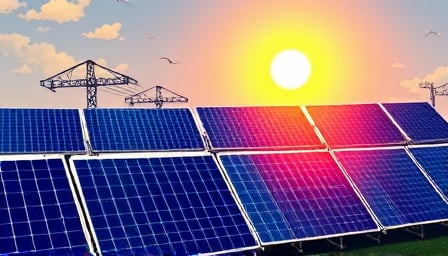Investigative Review of PG&E Corp’s Recent Corporate Actions
1. Executive Summary
PG&E Corp’s latest corporate filings and investor communications signal a deliberate shift toward sustainability‑driven growth and market‑positive sentiment. The company has reaffirmed its financial guidance, issued an updated presentation, and received a higher price target from Jefferies. Simultaneously, PG&E is launching the 2025 Pitch Fest to foster energy‑technology innovation and will introduce a California Climate Credit to its residential customers. While these developments are outwardly favorable, a deeper look at the underlying business fundamentals, regulatory landscape, and competitive dynamics reveals both opportunities and risks that merit close scrutiny.
2. Financial Fundamentals and Market Reception
| Item | Details | Implications |
|---|---|---|
| Reaffirmed Guidance | PG&E maintained its 2024 earnings and revenue forecasts, citing steady wholesale power prices and incremental renewable capacity. | Indicates management confidence but also suggests limited upside potential; potential over‑optimism if renewable ramp‑up is slower. |
| New Presentation | Highlights projected capital expenditures, cost‑control initiatives, and a 5‑year renewable portfolio target (25% of total generation). | Provides transparency but lacks granular assumptions for cost savings. Investors should verify the realistic nature of these savings. |
| Jefferies Price Target Increase | Jefferies raised its target from $38 to $43, maintaining a “Buy.” | Positive sentiment may be driven by PG&E’s clean‑energy narrative. Analysts should question whether the valuation reflects true intrinsic value or is inflated by ESG sentiment. |
| Stock Performance | Following announcements, the stock rose 1.8% intraday, stabilizing at 0.9% above the 20‑day SMA. | Short‑term gains align with market expectations; however, sustained performance will hinge on delivery of promised innovations and regulatory compliance. |
Financially, PG&E’s revenue mix remains heavily weighted toward regulated electricity sales, with only 5% derived from wholesale trading. This concentration makes the firm vulnerable to policy shifts in California’s energy market, which is experiencing rapid decarbonization and rate‑regulatory changes.
3. Regulatory Environment
California Climate Credit
- Mechanism: Automatic credit applied to residential electric bills starting October 2025 as part of the state cap‑and‑trade program.
- Projected Benefits: Analysts estimate a 10–12% reduction in average residential bill, translating to ~$150 million in savings for the 5.2 million PG&E customers.
- Risks: The credit’s value is tied to the California cap‑and‑trade allowance prices. A sudden tightening could increase PG&E’s compliance costs, offsetting consumer savings and compressing margins.
Renewable Portfolio Standards (RPS)
- PG&E must deliver 33% renewable electricity by 2025.
- The company’s plan to achieve this through a combination of solar PV, wind, and battery storage may be hampered by permitting delays and grid congestion.
Rate‑Regulation
- The California Public Utilities Commission (CPUC) maintains the authority to approve or modify PG&E’s rate adjustments.
- Recent CPUC rulings favor increased rates to support grid modernization, yet rate caps remain a significant uncertainty.
4. Competitive Dynamics
| Competitor | Strategy | Market Share | Threat Level |
|---|---|---|---|
| Southern California Edison’s (SCE) | Aggressive investment in micro‑grids and electric vehicle (EV) charging infrastructure | 12% of California’s electric customers | Moderate – SCE’s EV focus could siphon PG&E’s residential base |
| Tesla Energy | Solar+Storage bundles marketed directly to homeowners | 2% residential market | Low – niche but growing, could erode PG&E’s solar sales if pricing improves |
| Independent Power Producers (IPPs) | Large-scale solar farms with community solar programs | 5% of renewables | Moderate – IPPs are competing for the same renewable capacity credits |
PG&E’s 2025 Pitch Fest seeks to capture nascent innovations that could give the company a first‑mover advantage. However, the success of this competition will depend on the company’s ability to integrate startups’ solutions into its grid without compromising reliability.
5. Uncovered Trends and Potential Risks
Reliability vs. Decarbonization Trade‑off
- Accelerating renewable integration can strain grid stability, especially during peak demand periods. PG&E’s failure to deploy adequate storage could lead to outages, damaging its reputation and inviting regulatory penalties.
Cybersecurity Vulnerabilities
- The integration of IoT devices (e.g., smart meters) and the introduction of new startup solutions increase exposure to cyber attacks. Regulatory scrutiny post‑2021 has intensified, and any breach could have severe financial and reputational repercussions.
Customer Credit Impact on Revenue
- While the Climate Credit improves customer satisfaction, it simultaneously reduces PG&E’s taxable revenue. If the credit’s size expands beyond projections, revenue erosion could force the company to seek alternative revenue streams, such as higher fixed fees.
Capital Expenditure Uncertainty
- The firm’s 2024 CAPEX plan of $2.5 billion is ambitious. If construction delays occur, PG&E may need to refinance debt at unfavorable rates, impacting profitability.
6. Opportunities for Value Creation
- Strategic Partnerships: Leveraging the Pitch Fest finalists could allow PG&E to pilot low‑cost, high‑efficiency technologies (e.g., solid‑state transformers) that reduce maintenance costs.
- Data Monetization: Aggregated smart‑meter data could be sold to third parties (e.g., weather firms) under strict privacy agreements, generating ancillary income.
- Green Bonds: Issuing green bonds tied to renewable projects could attract ESG‑focused investors, lowering cost of capital.
7. Conclusion
PG&E Corp’s recent initiatives project a narrative of progressive transformation toward sustainability and customer value. Yet, the firm operates within a highly regulated, capital‑intensive environment where the convergence of regulatory risk, reliability challenges, and competitive pressures can erode expected upside. Investors should weigh the potential benefits of the Climate Credit and innovative initiatives against the inherent uncertainties in PG&E’s cost structure, regulatory compliance, and execution capabilities. A cautious yet informed stance—monitoring the company’s ability to deliver on its stated goals while scrutinizing regulatory developments—will best position stakeholders to navigate the evolving utilities landscape.
